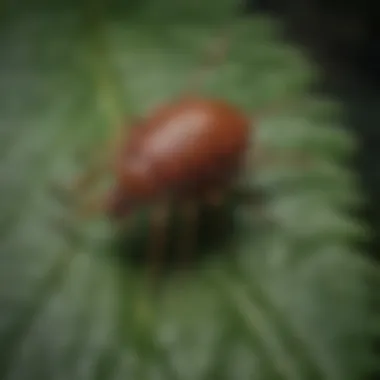Effective Yard Treatments for Ticks and Mosquitoes


Intro
Ticks and mosquitoes present significant challenges for homeowners seeking to enjoy their outdoor spaces. Understanding these pests is the first step in establishing proper yard treatments. This article will explore effective strategies for managing the presence of ticks and mosquitoes, highlighting chemical and natural methods available for effective pest control.
Additionally, we will delve into the life cycles and behaviors of these insects, emphasizing the importance of prevention. As we explore sustainable practices, this information aims to assist housewives and homeowners in making informed decisions that will help maintain a comfortable and safe environment in their yards.
Understanding Pests
Definition of Pests
Pests are organisms that negatively impact human activities, including agriculture, gardening, and leisure. Ticks and mosquitoes are small yet problematic pests, known for transmitting diseases and causing discomfort. Ticks are arachnids, while mosquitoes are flying insects from the family Culicidae. They share a common trait: their ability to thrive in environments that provide shelter and food, primarily through blood meals.
Importance of Pest Identification
Identifying ticks and mosquitoes is crucial for implementing effective treatment plans. Knowing the specific type of tick helps in recognizing potential diseases they may carry, such as Lyme disease or Rocky Mountain spotted fever. Understanding the different species of mosquitoes aids in assessing the risk of diseases like West Nile virus and Zika virus. Homeowners should familiarize themselves with their appearance and behavior. Ticks tend to hide in tall grass and wooded areas, while mosquitoes are attracted to standing water.
Prevention Techniques
Home and Garden Preventative Measures
Preventing the occurrence of ticks and mosquitoes requires a proactive approach. Here are some effective strategies:
- Maintain Landscaping: Keep grass well-trimmed and remove debris where ticks may hide.
- Manage Standing Water: Remove any stagnant water sources, such as buckets, bird baths, or clogged gutters.
- Install Barriers: Use fences or plant natural deterrents like marigolds or citronella.
Seasonal Prevention Tips
Seasonal changes impact the behavior of both ticks and mosquitoes. Here are seasonal tips:
- Spring: Begin treatments early in the season. Apply pesticides or introduce beneficial insects to control mosquito populations.
- Summer: Maintain awareness of standing water and continue regular yard maintenance.
- Fall: Prepare for colder months by cleaning up leaves and debris where ticks may seek refuge.
Eco-Friendly Pest Control Solutions
Overview of Sustainable Practices
Sustainable pest control focuses on minimizing environmental impact. Integrated Pest Management (IPM) combines various strategies, including biological and cultural controls. Homeowners can prioritize reducing chemical usage while maintaining effective pest control measures.
Natural Remedies and Their Effectiveness
Several natural remedies may help manage ticks and mosquitoes without harsh chemicals. Consider the following options:
- Essential Oils: Oils like lavender, eucalyptus, and tea tree oil can repel mosquitoes effectively.
- Diatomaceous Earth: This powdery substance can deter ticks and other pests when sprinkled in outdoor areas.
- Neem Oil: Known for its insect-repelling properties, neem oil can be effective against mosquitoes.
It's essential to test any remedies in small areas first to ensure effectiveness and safety.
Ultimately, establishing an effective yard treatment plan for ticks and mosquitoes requires a commitment to understanding the pests and embracing practical and eco-friendly solutions.
Understanding Ticks and Mosquitoes
Understanding ticks and mosquitoes is essential for effective pest management in residential yards. These pests are not just annoying; they pose significant health risks to humans and pets. Recognizing their life cycles and habitats allows homeowners to implement targeted control measures. This section dives into the factors that contribute to the presence of ticks and mosquitoes in your yard. By gaining insights into their behaviors, one can make informed decisions that enhance both outdoor enjoyment and safety.
The Life Cycle of Ticks


Ticks go through four stages: egg, larva, nymph, and adult. Understanding this life cycle is vital for managing their population. Ticks lay hundreds of eggs in the spring in humid areas, like leaf litter or undergrowth. When the eggs hatch, larvae emerge and seek hosts, usually small mammals. After feeding, they drop off to molt into nymphs, which are responsible for a large number of bites. Nymphs also require a blood meal to grow into adults, and they are active in late spring and summer when humans are outdoors more often. Adult ticks search for larger hosts for reproduction in the fall, as the female requires a meal to lay her eggs.
The Life Cycle of Mosquitoes
Mosquitoes undergo a similar but distinct life cycle. They have four stages: egg, larva, pupa, and adult. Female mosquitoes lay eggs in standing water. The larvae hatch and live in the water, feeding on organic matter. They then transform into pupae, which are also aquatic but do not feed. The adult emerges from the pupa, ready to fly. Understanding this cycle helps in identifying breeding grounds and implementing preventive measures. Different species of mosquitoes may have varying preferences for breeding sites, so this knowledge enables targeted treatments.
Health Risks Associated with Ticks
Ticks are known carriers of several diseases that can affect humans and pets. Lyme disease, for instance, is transmitted by the black-legged tick and can lead to severe health complications if untreated. Symptoms include fever, fatigue, and a characteristic rash. Other tick-borne illnesses include Rocky Mountain spotted fever and anaplasmosis. Prevention is crucial, as the risks associated with ticks are significant. This includes understanding how to recognize symptoms early and seeking medical help promptly.
Health Risks Associated with Mosquitoes
Mosquitoes are infamous for spreading diseases like West Nile virus and malaria. They bite during dusk and dawn, making protection important during these times. Mosquito bites can lead to allergic reactions and, most severely, vector-borne diseases. In addition to health threats, mosquitoes can impact outdoor activities, making backyard space less enjoyable. Understanding their behavior can be an effective part of a yard treatment strategy.
Importance of Prevention
Preventing ticks and mosquitoes from invading your yard is critical for the well-being of your family. Both insects not only cause annoyance but also pose significant health risks. Understanding the importance of prevention can help to minimize these risks while fostering a safe outdoor environment.
One of the core reasons to focus on prevention is the diseases associated with these pests. For instance, ticks can transmit Lyme disease, while mosquitoes can carry West Nile virus, Zika virus, and more. Effective prevention strategies can substantially reduce the chances of these illnesses spreading. When homeowners invest time in prevention, they are not only protecting their families but also safeguarding pets that can become infected too.
Also, creating a barrier against ticks and mosquitoes enhances the enjoyment of outdoor spaces. Families can use their backyards for gatherings, play, and relaxation without the constant worry of bites or disease transmission.
Moreover, preventive measures are often more cost-effective than dealing with infestations. Regular yard maintenance and awareness can drastically decrease the need for extensive pest control treatments. This can lead to both financial savings and a more manageable lifestyle. Investing in prevention allows for a proactive approach rather than a reactive solution.
"An ounce of prevention is worth a pound of cure."
By addressing the problem early, homeowners can avoid the stress of trying to eliminate an established population later on. Education on identifying tick and mosquito habitats contributes to more effective preventive measures, thereby diminishing the likelihood of an infestation.
Essentially, the focus on preventive strategies does not just benefit individual households; it positively impacts the larger community. Reduced tick and mosquito populations can lead to overall lower disease transmission rates, creating a healthier environment for everyone. Noise levels, unpleasant odors from chemical treatments, and potential harm to non-target species are also minimized when the right prevention measures are in place. This comprehensive approach supports sustainability and promotes harmony with the surrounding ecology.
In the next sections, we will discuss methods to identify tick and mosquito habitats, alongside yard maintenance strategies for effective pest control.
Chemical Treatment Options
Chemical treatments play a crucial role in managing ticks and mosquitoes effectively. These methods can provide rapid and significant reduction in pest populations when done correctly. Homeowners may find themselves in garden spaces increasingly invaded by these pests, prompting the need for interventions. Employing chemical insecticides is often considered an essential part of an integrated pest management strategy. The benefits of chemical treatments include speed of action and immediate effectiveness. However, it is equally important to consider the potential impacts on the environment and non-target species as well.
Insecticides for Ticks
When dealing with ticks, it is essential to select an appropriate insecticide that targets these specific pests. Common options include permethrin and bifenthrin. Permethrin works by disrupting the nervous system of ticks, leading to their eventual death. It is highly effective and can remain active for several weeks, ensuring extended protection. Bifenthrin, on the other hand, is a pyrethroid that has similar modes of action but offers a broader spectrum of control that can also help manage other pests.
Insecticides can be applied directly to yard areas where ticks are likely to thrive. This might include tall grass, shrubs, and shaded areas. Regular application is sometimes necessary, especially in the summer months when tick populations peak. Additionally, it’s wise to follow product instructions meticulously to avoid any adverse effects.
Insecticides for Mosquitoes
Mosquito control may also involve several insecticides approved for outdoor use. Commonly used products include malathion and pyrethroids. Malathion acts as an organophosphate, attacking the nerves of mosquitoes, which leads to paralysis and death. Its relatively quick effectiveness makes it a popular choice for many homeowners.
Pyrethroids, including products like cypermethrin and lambda-cyhalothrin, are favored for their rapid knockdown effect on mosquitoes. Applying these insecticides during the early evening hours, when mosquitoes are most active, minimizes exposure to beneficial insects like bees, which could be harmed by these chemicals.
Application Guidelines and Safety Precautions
Proper application of chemical insecticides is critical to ensure both efficacy and safety. Always read and understand the product label before application. Here are some important guidelines:
- Timing: Usually, pest control treatments are most effective when applied in the evening or early morning when pests are more active.
- Method: Use a sprayer or fogger as directed on the label. Avoid using a hose-end sprayer unless specified.
- Personal Protection: Wear protective clothing, including gloves and long sleeves, to minimize skin exposure. A mask may also be advisable to avoid inhalation of any fumes.
- Environmental Considerations: Avoid applying before rainfall and try to avoid windy days to prevent drift onto non-target areas.


Following these safety precautions is essential not just for personal safety but also for safeguarding local wildlife.
Keeping in mind the balance of effectiveness and environmental impact will create a more sustainable yard treatment strategy. Always opt for solutions that align with broader ecological goals while addressing the immediate challenges of pest management.
Natural Treatment Alternatives
Natural treatment alternatives for managing ticks and mosquitoes not only provide effective results but also align with environmentally conscious practices. As homeowners seek solutions that minimize the impact on surrounding ecosystems, these alternatives present valuable options. Utilizing non-chemical methods encourages a sustainable approach. Moreover, they can often be safer for pets and children who frequent yards. Understanding how these methods work allows homeowners to make informed choices that balance pest control with ecological responsibility.
Essential Oils and Their Effectiveness
Essential oils have garnered attention as a natural pest deterrent. Oils such as lemon eucalyptus, lavender, peppermint, and tea tree are recognized for their efficacy against ticks and mosquitoes. These oils possess potent properties that repel bugs due to their strong scents, which disrupt the insects’ ability to locate hosts.
To utilize essential oils, a typical method involves diluting a few drops with a carrier oil like coconut oil and applying it to the skin or clothing. Another approach is the use of oil in a spray mix, combined with water, to treat areas where ticks and mosquitoes are prevalent. Essential oils can also be added to diffusers or candles in outdoor spaces, creating a more pleasant environment while warding off pests.
The National Pesticide Information Retrieval System recommends certain essential oils as effective alternatives to conventional repellents.
Natural Repellents for Mosquitoes
Natural repellents can also decrease the presence of mosquitoes in residential yards. Ingredients such as citronella, catnip, and neem oil serve as alternatives to traditional insect repellents. Citronella candles or torches are popular for outdoor gatherings, creating a barrier that can reduce mosquitoes' presence significantly.
Using homemade sprays derived from these ingredients can be an effective method. For instance, a mixture of water with a few drops of citronella and some dish soap trapped inside can be sprayed around yard edges, particularly near standing water where mosquitoes breed. Importantly, ensuring the effectiveness of natural repellents requires consistent application, especially after rain.
Biological Control Methods for Ticks
Biological control methods involve the introduction of natural enemies to ticks. One effective approach is the use of nematodes, which are small worms that seek out ticks in soil. When applied to yards, these nematodes can significantly reduce tick populations by feeding on their larvae and pupae.
Another option involves attracting birds and beneficial insects that prey on ticks. Encouraging species like chickadees or purple martins can help naturally curb tick populations. Planting native flora also creates habitats for these predators and enhances the local ecosystem.
Homeowners should consider these biological methods as part of a broader pest management strategy. Combining these natural treatments while maintaining yard hygiene can improve overall effectiveness in tick control.
Integrated Pest Management Strategies
Integrated Pest Management (IPM) is a systematic approach that combines multiple strategies to manage pests effectively. This method is particularly crucial when dealing with ticks and mosquitoes, both of which pose health risks to humans and pets. Understanding the benefits of IPM allows homeowners to develop comprehensive pest control plans that minimize reliance on chemical treatments while still keeping the yard safe and healthy.
One core element of IPM is its emphasis on prevention. By identifying the specific conditions that attract ticks and mosquitoes, homeowners can adjust their practices accordingly. Maintaining a tidy yard, reducing standing water, and fostering a natural predator population are just a few ways to deter these pests.
Combining Chemical and Natural Approaches
The integration of both chemical and natural approaches is essential for effective pest management. Chemical treatments, such as insecticides, can provide rapid solutions for high pest populations. However, their indiscriminate use can harm beneficial insects and the broader ecosystem. This is where natural methods come into play.
For example, essential oils from plants like citronella and lavender can repel mosquitoes without the adverse effects associated with synthetic chemicals. By alternating between these methods, homeowners can create a balanced approach that is effective yet considerate of the environment.
- Key Benefits of Combining Approaches:
- Reduces chemical dependency
- Protects non-target species
- Allows for a more sustainable pest management strategy
Seasonal Treatment Scheduling
The timing of pest control measures can significantly influence their effectiveness. Mosquitoes and ticks have seasonal patterns in their life cycles. Understanding these patterns enables homeowners to schedule treatments at optimal times.
Spring is typically when both ticks and mosquitoes emerge. Applying treatments at this time can significantly reduce the populations before they reach peak numbers in summer. It's also important to have follow-up treatments in late summer, as some species may have multiple breeding cycles.
To implement effective seasonal scheduling, consider:


- Early Spring: Apply treatments to target early life stages of ticks and mosquitoes.
- Mid-Summer: Conduct mid-season assessments and re-treat if necessary.
- Late Summer: Target newly emerging populations that may pose a risk for fall gatherings.
By structuring pest treatments around the seasonal life cycles of these pests, homeowners can enhance effectiveness while minimizing unnecessary applications. This strategic approach ensures that your yard remains a safe space throughout the warmer months.
Assessing Effectiveness of Treatments
Understanding how effective your treatments are for ticks and mosquitoes is crucial for successful pest management. This not only helps in maintaining a comfortable outdoor space but also ensures that strategies employed are actually working. Assessing effectiveness involves regular monitoring to determine pest levels and adjusting treatments accordingly. Each step plays an important role in long-term pest management. It allows homeowners to allocate resources effectively while also minimizing unnecessary exposure to chemicals or other treatments, ultimately promoting a healthier ecosystem.
Monitoring Pest Populations
Monitoring the populations of ticks and mosquitoes is a significant part of pest management. Regular observation will help you gather data on the pest population over time. This can be done in various ways:
- Visual inspections: Check areas where ticks are likely to hide, such as tall grass or leafy debris. For mosquitoes, look for stagnant water sources.
- Use of traps: Installing traps can provide concrete data on mosquito and tick presence. Certain traps help in capturing samples for further analysis.
- Environmental assessments: Evaluating and documenting environmental conditions that can foster pest growth, such as humidity and breeding sites.
By relying on a combination of these methods, you can form a clearer picture of whether your treatments are reducing pest numbers effectively. This information becomes invaluable for making informed decisions about pest control moving forward.
Adjusting Treatment Plans Based on Results
Once you have gathered data through monitoring, the next step is to analyze that information and adjust treatment plans accordingly. This iterative process allows homeowners to respond to the real-time effectiveness of the strategies implemented. Consider the following:
- Identify ineffective treatments: If a particular approach is not yielding results, it may be time to consider an alternative. For example, if a specific insecticide doesn’t seem to work against mosquitoes, exploring other chemical options or natural deterrents is advisable.
- Seasonal adjustments: Different seasons bring varying pest activity; adjusting treatments to suit the seasonality can enhance effectiveness. For instance, applying certain treatments before peak mosquito breeding times can control populations more effectively.
- Feedback loop: Employing a feedback loop can enhance the understanding of treatment outcomes. Regularly compile feedback on observed pest reduction and satisfaction to update strategies.
In summary, regularly assessing the effectiveness of your pest management strategies can lead to significant improvements over time. Through careful monitoring and adaptation to results, you not only secure your home environment but also contribute to sustainable pest management practices.
Ecological Considerations
In the realm of pest control, understanding ecological considerations is crucial. This is not simply about eliminating ticks and mosquitoes. It involves recognizing the broader impacts of treatment strategies on the environment. Effective pest management must balance the need for protection against these pests with the preservation of local ecosystems. By addressing ecological considerations, homeowners can make informed choices that do not inadvertently harm beneficial species or disrupt natural habitats.
Impact of Chemical Treatments on Non-target Species
The use of chemical treatments for managing ticks and mosquitoes can have unintended consequences. These substances are designed to target specific pests, but they do not discriminate between harmful and non-harmful organisms.
- Beneficial Insects: Insecticides can kill pollinators like bees, which are essential for plant reproduction. Their decline can affect gardens and local flora.
- Wildlife: Birds and small mammals may ingest treated insects, leading to poisoning and death. These species play vital roles in your yard’s ecosystem.
- Soil Health: Chemical runoff can deteriorate soil quality, harming beneficial microorganisms essential for a healthy yard.
To mitigate these risks, homeowners should consider using targeted application methods or choosing less harmful alternatives.
Sustainable Pest Management Practices
Sustainable pest management incorporates practices that prioritize environmental health while effectively controlling pests.
- Integrated Pest Management (IPM): This approach combines cultural, biological, and chemical practices. It focuses on prevention first and utilizes chemicals as a last resort.
- Organic Treatments: These options, such as neem oil or diatomaceous earth, are less harmful to non-target species. They provide a more balanced approach to pest control.
- Encouraging Beneficial species: Planting native species attracts beneficial insects and natural predators of ticks and mosquitoes.
- Habitat Modification: Making changes to your yard, such as improving drainage or reducing standing water, can greatly diminish pest populations naturally.
By adopting these practices, homeowners can effectively reduce tick and mosquito populations while maintaining ecological balance.
Culmination and Best Practices
The process of managing ticks and mosquitoes in residential areas demands careful consideration of various methods and practices. With the growing awareness of health risks and ecological effects, the choice of yard treatment becomes crucial. This section outlines the importance of effective strategies while solidifying key practices that enhance pest control outcomes.
Comprehensive yard treatment encompasses both preventive measures and treatments. Homeowners must realize that tackling these pests is not solely about eradication but also about maintaining a healthy environment. This shift in perspective can lead to longer-lasting results and much-needed peace of mind.
Certain benefits improve overall methods of pest control. For example, combining natural treatments with chemical options can yield effective results while supporting ecological health. Additionally, consistent yard maintenance enhances the longevity of these treatments. Regular monitoring and evaluation of pest populations ensure that any adjustments can be made in a timely manner.
Effective pest management is a continuous process that requires attention and adaptability.
Considerations around environmental impacts also play a critical role. Homeowners should lean toward sustainable options whenever possible, thus reducing harm to non-target species. The choice of biological methods or targeted chemicals can significantly lower risks to beneficial insects and local wildlife. It is essential to stay informed about the latest products and techniques for pest management.
Summary of Key Strategies
- Maintain a clean yard: Regularly remove debris, leaves, and stagnant water to reduce breeding grounds for mosquitoes. Keep grass trimmed and shrubs well-maintained.
- Use a combination of treatments: Integrate chemical and natural methods to ensure efficacy without extensive environmental damage. Essential oils, such as citronella or eucalyptus, can be effective against mosquitoes.
- Regularly monitor pest populations: Keep track of the pest activity in your yard. This practice helps adjust treatment plans timely and effectively.
- Schedule seasonal treatments: Align pest control measures with seasonal changes, as pest activities vary. This scheduling maximizes treatment effectiveness.
- Educate yourself on safe product application: Understand how to handle and apply chemicals responsibly. Proper use is key in preventing adverse reactions and ensuring safety for pets and children.



